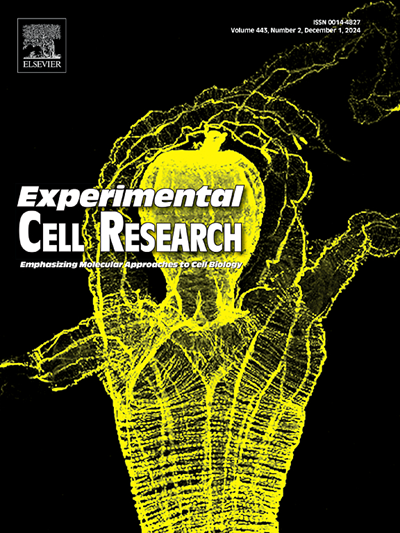PM2.5诱导细胞死亡的时间动态:强调炎症是延长心肌毒性后期的关键介质。
IF 3.3
3区 生物学
Q3 CELL BIOLOGY
引用次数: 0
摘要
多种形式的细胞死亡对心血管疾病有重要贡献,对心脏重塑产生负面影响并导致心力衰竭。虽然心肌细胞死亡与PM2.5诱导的心脏毒性有关,但与炎症过程相关的各种细胞死亡形式(如凋亡、铁下垂、坏死下垂和焦下垂)的时间动力学仍未得到充分探讨。本研究在Wistar大鼠模型中研究了心肌中这些细胞死亡途径的时间依赖性发生和进展及其与炎症的相关性。雌性大鼠在1,7,14和21天内每天暴露于250 μg/m³的PM2.5中3小时。基因表达分析显示,凋亡标志物(caspases 3、7和9)在暴露7天后上调,并在21天内持续升高。铁溶性标志物,如铁蛋白和GPX4,从第14天开始显著下降,而坏死(RIPK1)和焦亡(GSDMD)仅在暴露21天后才突出。与此同时,炎症标志物,包括IL-1β和TNF-α,显示出显著的上调,特别是在后期,这表明炎症在延长暴露期放大心肌损伤中起关键作用。这些过程与线粒体质量逐渐减少、氧化应激升高和生物能量功能受损相吻合,所有这些都导致第21天心功能恶化和重构。综上所述,PM2.5暴露主要通过早期细胞凋亡和铁下垂引起心肌损伤。然而,长时间的暴露会通过坏死和焦亡加剧细胞死亡,炎症成为驱动晚期心肌毒性的关键因素。这项研究强调了不同细胞死亡途径的时间动态,为PM2.5诱导心脏毒性的机制提供了重要的见解,并确定了减轻其影响的潜在治疗靶点。本文章由计算机程序翻译,如有差异,请以英文原文为准。
Temporal dynamics of PM2.5 induced cell death: Emphasizing inflammation as key mediator in the late stages of prolonged myocardial toxicity
Multiple forms of cell death contribute significantly to cardiovascular pathologies, negatively impacting cardiac remodeling and leading to heart failure. While myocardial cell death has been associated with PM2.5 induced cardiotoxicity, the temporal dynamics of various cell death forms, such as apoptosis, ferroptosis, necroptosis, and pyroptosis, in relation to inflammatory processes, remain underexplored. This study examines the time-dependent onset and progression of these cell death pathways in the myocardium and their correlation with inflammation in a Wistar rat model. Female rats were exposed to 250 μg/m³ of PM2.5 for 3 h daily over periods of 1, 7, 14, and 21 days. Gene expression analysis revealed that apoptotic markers (caspases 3, 7, and 9) were upregulated after 7 days of exposure, with continued elevation through 21 days. Ferroptotic markers, such as Ferritin and GPX4, declined significantly starting from day 14, while necroptosis (RIPK1) and pyroptosis (GSDMD) were prominent only after 21 days of exposure. In parallel, inflammatory markers, including IL-1β and TNF-α, showed substantial upregulation, particularly in the later stages, suggesting that inflammation plays a key role in amplifying myocardial damage in the prolonged exposure phase. These processes coincided with a progressive decrease in mitochondrial mass, elevated oxidative stress, and compromised bioenergetic function, all contributing to worsened cardiac function and remodeling by day 21.In conclusion, PM2.5 exposure initiates myocardial damage primarily through apoptosis and ferroptosis in the early stages. However, prolonged exposure exacerbates cell death via necroptosis and pyroptosis, with inflammation emerging as a critical factor driving late-stage myocardial toxicity. This study highlights the temporal dynamics of distinct cell death pathways, offering crucial insights into the mechanisms of PM2.5 induced cardiotoxicity and identifying potential therapeutic targets to mitigate its impact.
求助全文
通过发布文献求助,成功后即可免费获取论文全文。
去求助
来源期刊

Experimental cell research
医学-细胞生物学
CiteScore
7.20
自引率
0.00%
发文量
295
审稿时长
30 days
期刊介绍:
Our scope includes but is not limited to areas such as: Chromosome biology; Chromatin and epigenetics; DNA repair; Gene regulation; Nuclear import-export; RNA processing; Non-coding RNAs; Organelle biology; The cytoskeleton; Intracellular trafficking; Cell-cell and cell-matrix interactions; Cell motility and migration; Cell proliferation; Cellular differentiation; Signal transduction; Programmed cell death.
 求助内容:
求助内容: 应助结果提醒方式:
应助结果提醒方式:


